
John Kilian Houston Brunner was a British author of science fiction novels and stories. His 1968 novel Stand on Zanzibar, about an overpopulated world, won the 1969 Hugo Award for best science fiction novel, and the BSFA award the same year. The Jagged Orbit won the BSFA award in 1970.

Mars, the fourth planet from the Sun, has appeared as a setting in works of fiction since at least the mid-1600s. It became the most popular celestial object in fiction in the late 1800s as the Moon was evidently lifeless. At the time, the predominant genre depicting Mars was utopian fiction. Contemporaneously, the mistaken belief that there are canals on Mars emerged and made its way into fiction. The War of the Worlds, H. G. Wells' story of an alien invasion of Earth by sinister Martians, was published in 1897 and went on to have a large influence on the science fiction genre. Life on Mars appeared frequently in fiction throughout the first half of the 1900s. Apart from enlightened as in the utopian works from the turn of the century, or evil as in the works inspired by Wells, intelligent and human-like Martians also began to be depicted as decadent, a portrayal that was popularized by Edgar Rice Burroughs in the Barsoom series and adopted by Leigh Brackett among others. Besides these, more exotic lifeforms appeared in stories like Stanley G. Weinbaum's "A Martian Odyssey". The theme of colonizing Mars replaced stories about native inhabitants of the planet in the second half of the 1900s following emerging evidence of the planet being inhospitable to life, eventually confirmed by data from Mars exploration probes. A significant minority of works nevertheless persisted in portraying Mars in a way that was by then scientifically outdated, including Ray Bradbury's The Martian Chronicles. Terraforming Mars to enable human habitation has been another major theme, especially in the final quarter of the century, with the most prominent example being Kim Stanley Robinson's Mars trilogy. Stories of the first human mission to Mars appeared throughout the 1990s in response to the Space Exploration Initiative. The moons of Mars—Phobos and Deimos—have made only sporadic appearances in fiction.

Science fiction is a genre of speculative fiction which typically deals with imaginative and futuristic concepts such as advanced science and technology, space exploration, time travel, parallel universes, extraterrestrial life, sentient artificial intelligence, cybernetics, certain forms of immortality, and the singularity. Science fiction predicted several existing inventions, such as the atomic bomb, robots, and borazon, whose names entirely match their fictional predecessors. In addition, science fiction might serve as an outlet to facilitate future scientific and technological innovations.

The Day the Earth Stood Still is a 1951 American science fiction film from 20th Century Fox, produced by Julian Blaustein and directed by Robert Wise. It stars Michael Rennie, Patricia Neal, Hugh Marlowe, Sam Jaffe, Billy Gray, Frances Bavier and Lock Martin. The screenplay was written by Edmund H. North, based on the 1940 science fiction short story "Farewell to the Master" by Harry Bates, and the film score was composed by Bernard Herrmann.

The alien invasion or space invasion is a common feature in science fiction stories and film, in which extraterrestrial lifeforms invade the Earth either to exterminate and supplant human life, enslave it under an intense state, harvest people for food, steal the planet's resources, or destroy the planet altogether.

Science fiction is a film genre that uses speculative, fictional science-based depictions of phenomena that are not fully accepted by mainstream science, such as extraterrestrial lifeforms, spacecraft, robots, cyborgs, interstellar travel, time travel, or other technologies. Science fiction films have often been used to focus on political or social issues, and to explore philosophical issues like the human condition.

An overwhelming majority of fiction is set on or features the Earth. This also holds true of science fiction, despite perceptions to the contrary. Counterfactual depictions of the shape of the Earth, be it flat or hollow, occasionally are featured. A personified, living Earth appears in a handful of works. In works set in the far future, Earth can be a center of space-faring human civilization, or just one of many inhabited planets of a galactic empire, and sometimes destroyed by ecological disaster or nuclear war or otherwise forgotten or lost.
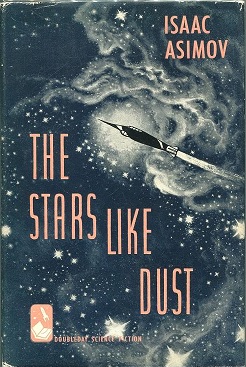
The Stars, Like Dust is a 1951 science fiction mystery book by American writer Isaac Asimov.

Planetary romance is a subgenre of science fiction in which the bulk of the action consists of adventures on one or more exotic alien planets, characterized by distinctive physical and cultural backgrounds. Some planetary romances take place against the background of a future culture where travel between worlds by spaceship is commonplace; others, particularly the earliest examples of the genre, do not, and invoke flying carpets, astral projection, or other methods of getting between planets. In either case, it is the planetside adventures which are the focus of the story, not the mode of travel.

The planet Venus has been used as a setting in fiction since before the 19th century. Its impenetrable cloud cover gave science fiction writers free rein to speculate on conditions at its surface; the planet was often depicted as warmer than Earth but still habitable by humans. Depictions of Venus as a lush, verdant paradise, an oceanic planet, or fetid swampland, often inhabited by dinosaur-like beasts or other monsters, became common in early pulp science fiction, particularly between the 1930s and 1950s. Some other stories portrayed it as a desert, or invented more exotic settings. The absence of a common vision resulted in Venus not developing a coherent fictional mythology, in contrast to the image of Mars in fiction. When portrayed, the native sentient inhabitants, Venusians, were generally portrayed as gentle, ethereal and beautiful. Early science fiction writers who set their stories on Venus included Otis Adelbert Kline in the 1920s; Edgar Rice Burroughs, Olaf Stapledon, and Stanley G. Weinbaum in the 1930s; Robert A. Heinlein, Henry Kuttner, and C. S. Lewis in the 1940s; and Isaac Asimov and Frederik Pohl in the 1950s.

An extraterrestrial or alien is any extraterrestrial lifeform; a lifeform that did not originate on Earth. The word extraterrestrial means "outside Earth". The first published use of extraterrestrial as a noun occurred in 1956, during the Golden Age of Science Fiction.
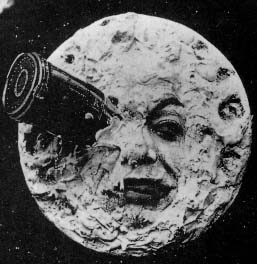
The Moon has appeared in fiction as a setting since at least classical antiquity. Throughout most of literary history, a significant portion of works depicting lunar voyages has been satirical in nature. From the late 1800s onwards, science fiction has successively focused largely on the themes of life on the Moon, first Moon landings, and lunar colonization.
Saturn has made appearances in fiction since the 1752 novel Micromégas by Voltaire. In many of these works, the planet is inhabited by aliens that are usually portrayed as being more advanced than humans. The planet is occasionally visited by humans and its rings are sometimes mined for resources. The moons of Saturn have been depicted in a large number of stories, especially Titan with its Earth-like environment suggesting the possibility of colonization by humans and alien lifeforms living there.
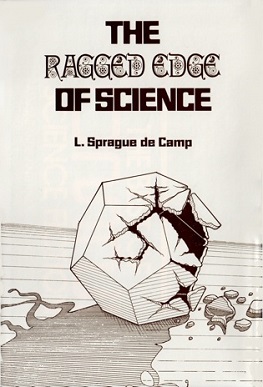
The Ragged Edge of Science is a science book by L. Sprague de Camp, illustrated by Don Simpson. It was first published by Owlswick Press in 1980.
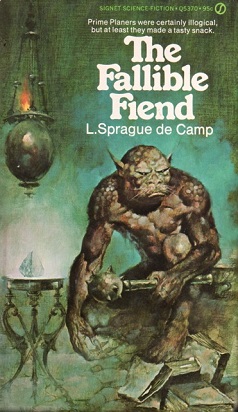
The Fallible Fiend is a fantasy novel by American writer L. Sprague de Camp, the third book of his Novarian series. It was first published as a two-part serial in the magazine Fantastic for December 1972 and February 1973, and subsequently expanded and revised for book publication. The novel was first published in book form as a paperback by Signet Books in 1973; it was later reprinted by Remploy (1974), Sphere (1978), Del Rey/Ballantine (1981), Baen (1992) and the Thorndike Press (2002). The Remploy edition was both the first British and first hardcover edition. An e-book edition was published by Gollancz's SF Gateway imprint on September 29, 2011 as part of a general release of de Camp's works in electronic form. It has also been translated into German and Italian.

The concepts of space stations and space habitats feature in science fiction. The difference between the two is that habitats are larger and more complex structures intended as permanent homes for substantial populations, but the line between the two is fuzzy with significant overlap and the term space station is sometimes used for both concepts. The first such artificial satellite in fiction was Edward Everett Hale's "The Brick Moon" in 1869, a sphere of bricks 61 meters across accidentally launched into orbit around the Earth with people still onboard.
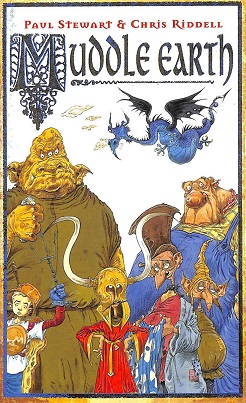
Muddle Earth is a children's novel by Paul Stewart, published in 2003, and illustrated by Chris Riddell. It is largely a parody of The Lord of the Rings by J. R. R. Tolkien. Like LOTR it is divided into three sections: Englebert the Enormous, Here Be Dragons and Doctor Cuddles of Giggle Glade. In 2011, a sequel titled Muddle Earth Too was published.
Comets have appeared in numerous works of fiction. One of the earliest such works is Edgar Allan Poe's 1839 short story "The Conversation of Eiros and Charmion", wherein the Earth's atmosphere is lost to a comet, with catastrophic results. Destruction is also caused by impact events in works such as the 1977 novel Lucifer's Hammer by Larry Niven and Jerry Pournelle, and the impact of Comet Shoemaker–Levy 9 on Jupiter in 1994 was satirized by Terry Pratchett in his 1998 Discworld novel The Last Continent. Looming threats posed by comets are depicted in many works including Dennis Wheatley's 1939 novel Sixty Days to Live. Conversely, H. G. Wells' 1906 novel In the Days of the Comet provides a rare example of positive effects arising from Earth encountering a comet, the gases in the comet's tail altering the atmosphere in a way that transforms human character for the better.
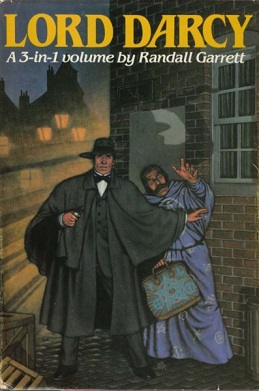
Lord Darcy is a 1983 omnibus collection of two previous fantasy collections and one fantasy novel by Randall Garrett featuring his alternate history detective Lord Darcy, published by Doubleday as a selection in its Science Fiction Book Club. The component books had originally been published in 1966, 1979 and 1981. The collection was reissued in 1999. A second edition, edited by Eric Flint, was published by Baen Books in 2002. The second edition reorganized the contents, added two stories not included in the original edition or its component volumes, and was edited slightly to remove duplicative material.
Galactic Gigolo is a 1987 American science fiction comedy film directed by Gorman Bechard.














